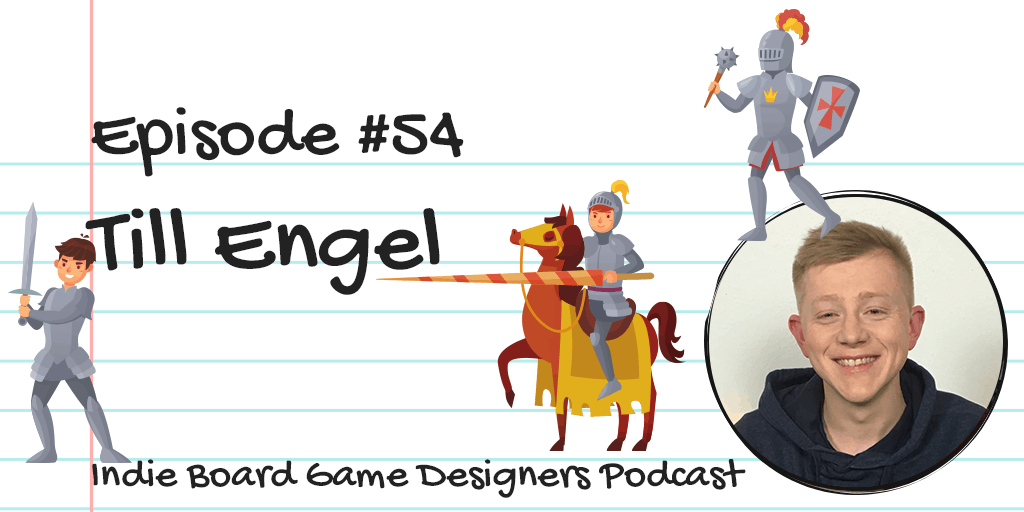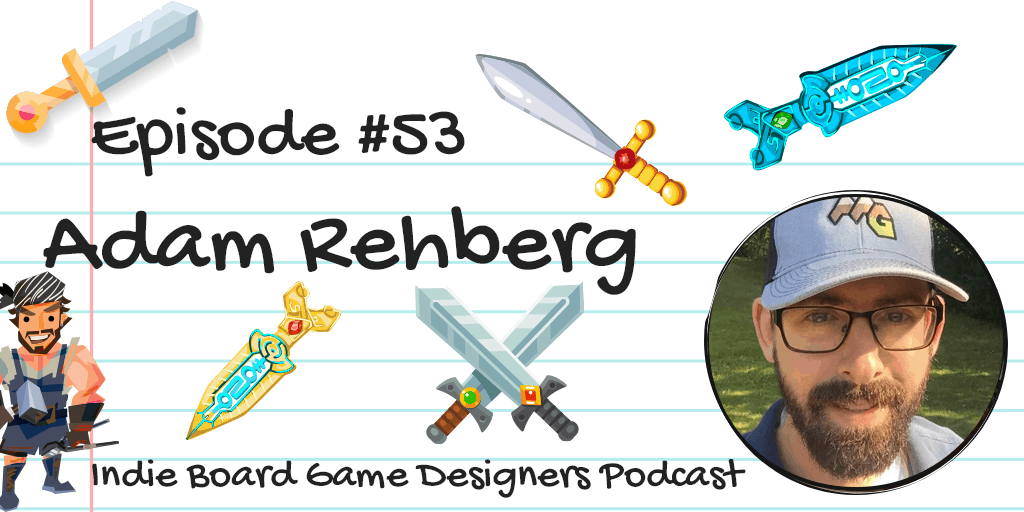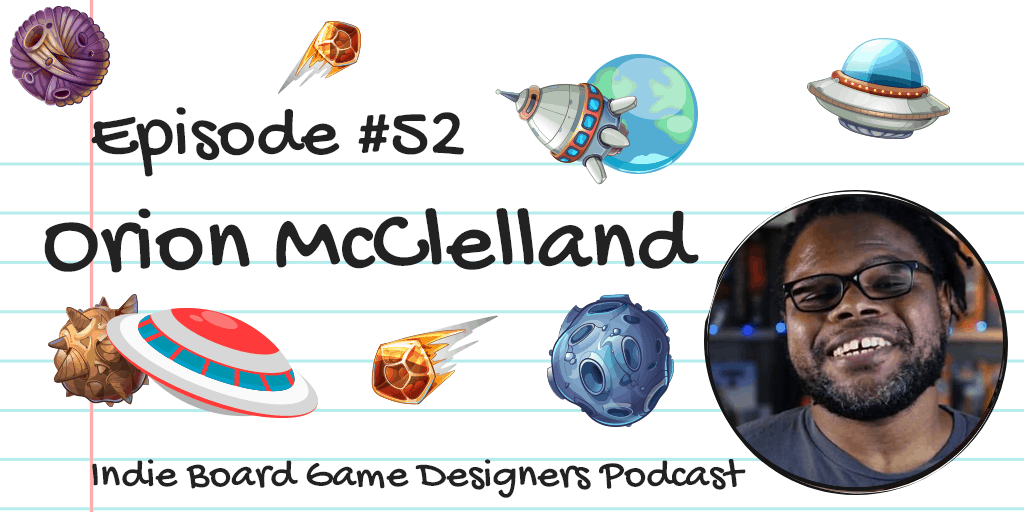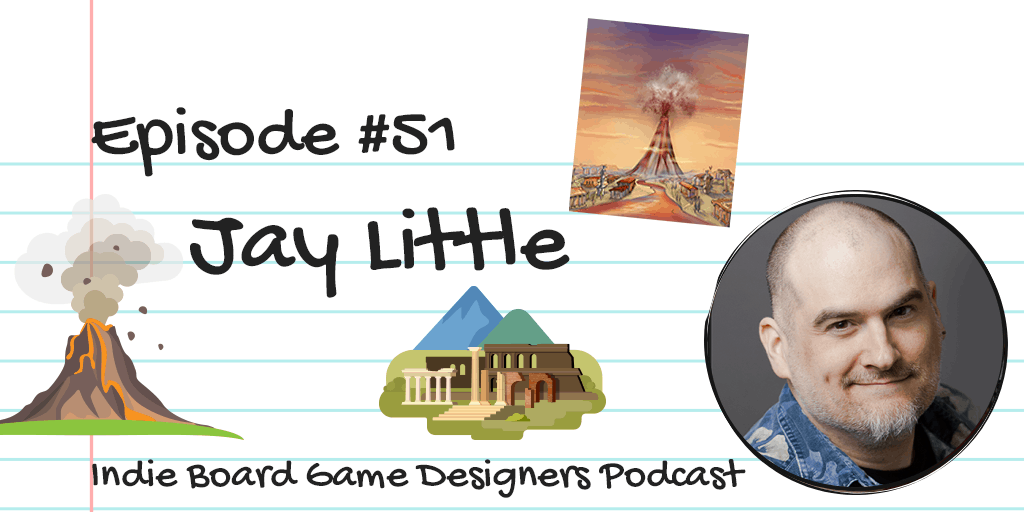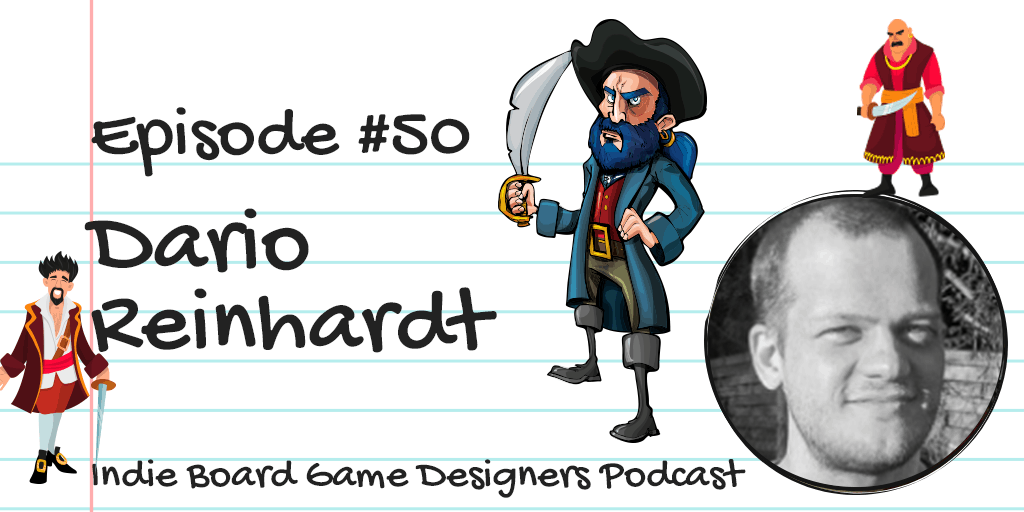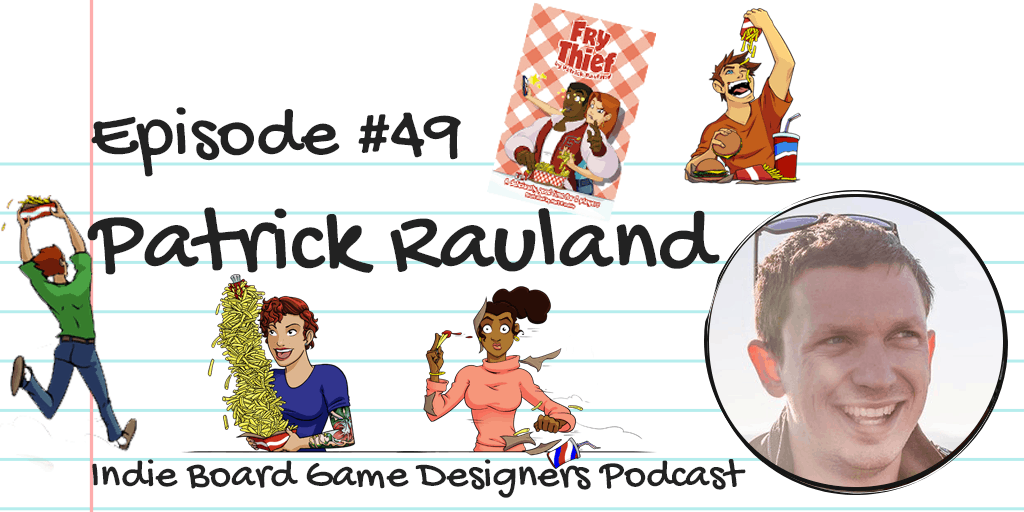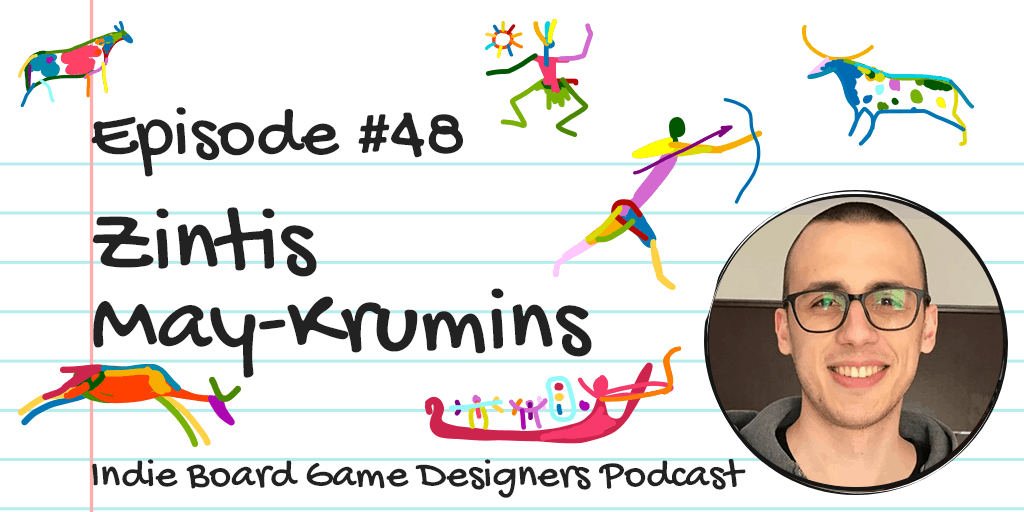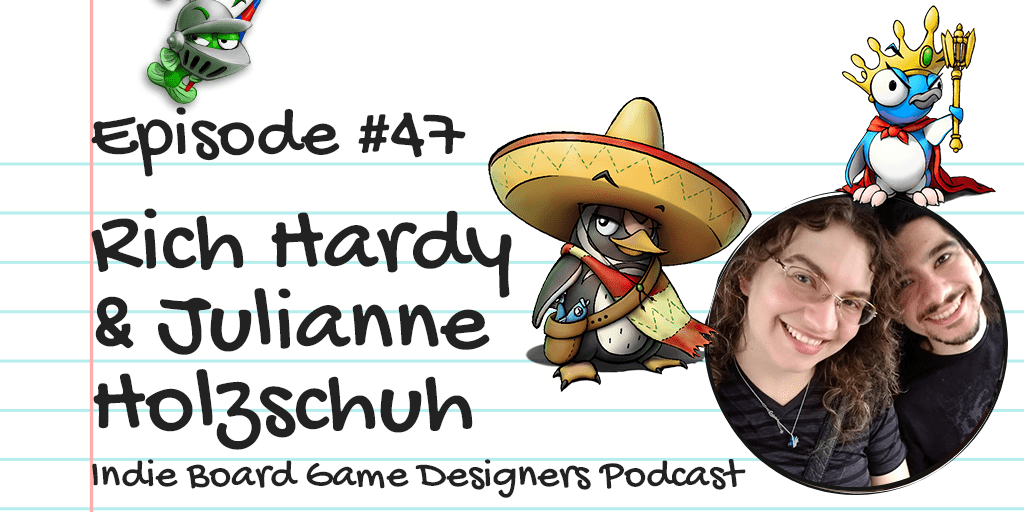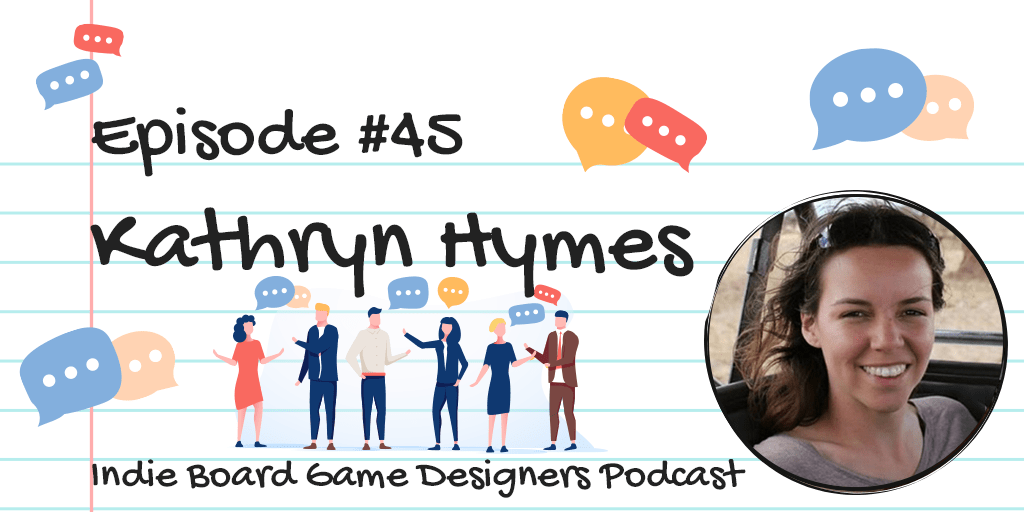Podcast: Play in new window | Download
Subscribe to podcast: Apple Podcasts |
Patrick Rauland: Hello everyone, and welcome to the Indie Board Game Designers Podcast, where I sit down with a different independent game designer every single week, and we talk about their experience in game design and what they've learned along the way. My name is Patrick Rauland, and today I'm going to be talking with Zintis May-Krumins, who designed Cave Paintings, where you're basically a cave person trying to crudely draw images and have other people guess them. Zintis, welcome to the show.
Zintis May-Krumins: Hi. I'm really happy to be here. Thanks for having me on.
Introduction
Patrick Rauland: So, I want to get into drawing games a little bit later, because I don't think I've talked to anyone yet who's made a drawing game, which is just a whole different thing. But I like to start with a little basically getting to know you game, because I've already researched you but the audience hasn't. So, are you a fan of 2001: A Space Odyssey?
Zintis May-Krumins: I am a fan, although I have not seen it since I was a kid, and if you talked to my friends, you would know that, like, we joke about how I think everything's better in space, like space games, and novels, and movie … everything. Everything's better in space.
Patrick Rauland: Have you ever done a DNA test, and if so, do you have any neanderthal DNA?
Zintis May-Krumins: I have never done a DNA test, and I probably never will. I feel like that's one of those things where the best case scenario is what exactly? Like, maybe you learn that someone's not related to you, and that would be horrible, but like what's the best case scenario, that like, “Oh, I don't know.”
Patrick Rauland: So, number one, I have neanderthal DNA. I got a DNA test from 23andme.com. It was really easy. Here's what I was hoping for, but sadly did not happen. I was hoping for a secret long-lost brother. Like, that would be so cool, to have a secret half-brother or secret half-sister. I want to have that family drama, but sadly, no, just nothing.
Zintis May-Krumins: No family drama for you. All right.
Patrick Rauland: I mean, so the good news is I'm keeping myself open to possibilities. If this secret half-brother or half-sister ever takes the DNA test, I will be notified, so-
Zintis May-Krumins: Okay.
Patrick Rauland: So that is the upside. I'm just letting you know.
Zintis May-Krumins: That's the win right there. Okay.
Patrick Rauland: So do you have any favorite caveman games besides your own?
Zintis May-Krumins: I think it has to go to Stone Age. I don't think I know that many caveman games, actually, so that's-
Patrick Rauland: There should be more.
Zintis May-Krumins: … the only one that comes to mind that I've played.
How Did You Get Into Board Games and Board Game Design?
Patrick Rauland: Yeah. Cool. Cool. Okay, so let's get into the first real question. I just love, like how did you get into board games and board game design?
Zintis May-Krumins: Board games, I've played games almost my entire life. I think I was playing chess when I was really little. I spent some time playing Magic, and Warhammer, Poker, StarCraft, all that stuff, all throughout my life at different times. Some of them, I played more rigorously than others. Like, I played competitive Magic for a few years in high school. I've played poker for reasonably serious money in my 20s, although that's kind of died out since I think I lost my competitiveness a little bit. And let's see. This must have been in 2007 or ‘8, my friends introduced me to Catan, and that introduced me to a bunch of other of these gateway games at that time. And my friends had a copy of Twilight Imperium on his shelf that he'd never played, and I'm like, “That looks amazing. I have to try that.” So we did, and it's been a mess ever since.
Patrick Rauland: Just curious, do you happen to know what version of Twilight Imperium?
Zintis May-Krumins: It was third edition. I actually believe I traded … I think I actually have that copy in my house right now. I traded him a board game he was likely to play in exchange for it, since like he never played it himself, so now I have my own gateway game. My initial gateway game is in my living room. All right, so that's how I got into board games, and the rest of the question is board game design?
Patrick Rauland: Yeah, yeah.
Zintis May-Krumins: Okay, so I think in 2011 or 2012, I was like listening to various podcasts that had me … I think that they were video game podcasts, like the Co-Optional podcast, and that got me kind of listening to a couple just general game design podcasts, and like Extra Credits on YouTube. And at some point, I was like, “Huh, that seems interesting and fun. Might be good to try it one day.” And that got me, like, very lightly interested into the idea of game design. At that point, I had this kind of like scheme, that maybe I'd study some game design, and then I'd study some programming, and later, some time in the future, I could combine them and make a game.
Zintis May-Krumins: But what actually ended up happening was that both of these two skillsets have stayed completely separate so far. So, in 2011, at the time, I was working in a casino. I was a poker dealer. But now, I'm a web developer, so programming happened, and also at that time, I was just playing games, but now I'm also designing tabletop games, so they have not met yet.
JavaScript is Totally Related To Board Game Design. 🙄
Patrick Rauland: You're a web developer. I also have a web background, so I should have asked you what is like your favorite JavaScript language, just because then I feel like you can get hate from all sides, because you'll pick the wrong one inevitably.
Zintis May-Krumins: I just learned some Vue last couple days, and I've really been enjoying that, because I've spent some time learning Angular too and React, because my senior dev just loves React, and I kind of don't like both of those for different reasons. I like Angular a little more, because it's very developer friendly. It's very easy to program in. I appreciate that React is very fast, but it's hard to program in. But Vue seems to be like that very happy medium, although I haven't done it in production yet, so … But we're getting really heavy for our listeners, so-
How Do You Make A Drawing Game?
Patrick Rauland: Well, yeah. We're getting super nerdy. Yeah, yeah, but … So, I'm really excited to talk about your drawing game, so … Hold on, let me pull up the title before I mash the … Okay, so Cave Paintings. You made a game called Cave Paintings, where basically, the premise, if I could try to summarize it in one sentence, is like you're a caveman, you're trying to get across a word or phrase to someone else, but you can only draw basically with your fists. You hold the pen in your fist and you make these crude drawings, which the videos that I saw look hilarious. So, how did you decide to make a drawing game? Because you also seem pretty attracted to Twilight Imperium, like super big, heavy, complex games.
Zintis May-Krumins: Yeah, so the weird thing … I'm not a professional game designer. I'm an indie game designer. I do this for enjoyment. I enjoy games in general, and developing games is kind of like an extension of that, so a lot of times, I'll make a game for the sheer challenge of it. I'm not restricted to games that I like, per se. I've made a couple that I don't like, which is weird when playtesting. So, what I'm trying to say is that, like, I just hadn't … Usually, my game design process just starts with an idea. I'm like, “Oh, this concept would be really cool,” or, “This mechanic would be really cool,” and then I'll just kind of like flesh out the idea of that game around it, and this might take a few days, a few weeks, a few months for that idea to congeal, until it seems like it could be real. And then I'll try to prototype it, think it through, and get some playtesting done, and if it goes well, I keep going with it, and if it doesn't, then it ends up in the archive folder in my Google Drive.
Patrick Rauland: Yes.
Zintis May-Krumins: So, how did I end up with a drawing game? What ended up happening there was that at that point, I think I had like … It must have been in … No, this was in 2016. I remember because I was in a web development class at the time. So it was in 2016. I had been trying to develop games for about two years. In 2015, I had gone to BostonFIG with one of my projects, called Huts, so like I had done some game design up until that point, maybe 15 or 20 iterations of various games. And that winter, at a friend's … I think it was like a New Year's party. Everyone was playing Jackbox Party Pack, like in their living room, and they were playing one of the drawing games that was on there.
Zintis May-Krumins: And I remember that like I drew something, and it showed up on the TV, and then a graphic designer and an illustrator both stood up and yelled out, “Who drew that? That's amazing. How did you draw …” and like, at that moment, I realized that like drawing well in drawing games isn't the fun part, because I kind of got picked out for having such a better drawing. We were having so much more fun making terrible guesses, and like making terrible drawings, like with everybody else's drawings. Then mine came out as like, I don't know, like a five-year-old's drawing. Everyone else's looked like someone just mashed their screens, basically.
Zintis May-Krumins: And I kind of just realized at that moment that games like Pictionary, which incentivize good drawing, or other games that do that, are like that's not necessarily where the fun is. Like, there's some fun there, but I feel like bad drawings and bad guesses were the best way to have fun with a drawing game, and that's where it came from.
Patrick Rauland: Yeah. I find this really interesting, because I … So the only other drawing game that I really know, yeah, Pictionary and then Telestrations, and Telestrations seems similar, where you don't intentionally draw bad, but when bad drawings happen, that is the fun.
Zintis May-Krumins: Yeah, that's the best part.
Why Is Messing Up Fun?
Patrick Rauland: Are there other … I'm just trying to think out loud here. Are there other games where basically, people messing up is fun, and are they all like party games?
Zintis May-Krumins: I think party games are the games that were going to do that, because in party games, winning and losing doesn't matter. It's mostly about the experience for the players. You can't do anything super strategic, that has people randomly flubbing for humor … Well, I mean you can. It'll happen, but like you don't enter a game of Agricola planning on flubbing on turn 12.
Patrick Rauland: Sure.
Zintis May-Krumins: But you do enter a game of Pictionary trying to make someone guess something ridiculous, because that's fun. But like as far as drawing games that are trying to make people draw bad, I do remember that like Doodle Rush and Really Bad Art both came out kind of like while I was developing Cave Paintings, which kind of made me a little nervous, but I think the games are different enough, and I think that I'm pushing that concept a little bit further than those did.
Do You Start With Theme or Mechanics?
Patrick Rauland: Nice. Nice. So, I just want to go back to something. You said you start with basically an idea, and then you said … So, I just want to take us back to the age-old game design question of mechanics or theme first, because it seems like you do both.
Zintis May-Krumins: Yeah. I personally find that, like, you might start with one or the other, but at some point, you're going to have to introduce both to your game, and very often, I feel that when I'm trying to make a mechanical decision in a game, like what are the mechanisms are going to fit with this little contraption I've made? Like having a theme inform your decisions makes it easier to make those kind of otherwise arbitrary mechanical decisions. Like, let's say I have an area control game. If it's all done in a vacuum, and you have a purely abstract area control game, you could do anything, but like why?
Zintis May-Krumins: But if you said it was an area control game about, like, ancient Rome in the senate, now you're trying to influence politicians, and that's go kind of dictate what kinds of mechanics you want to have, and like what the game pieces are going to look like, and so forth. It becomes much easier to develop a game when you have both some theme and some mechanisms, but also understanding that like mechanisms can be transplanted from game to game. You don't need to have a specific theme, necessarily, but having something inform your decisions really helps the design process, especially early on.
Patrick Rauland: I totally, totally agree. Just, I think it helps guide you, but yeah, I guess I'd say the theme helps guide your mechanism decisions, but it isn't … You don't need it, and you don't need until later, but I think it's helpful.
Zintis May-Krumins: So a funny thing is that I've actually had that argument with some people, because I'm the middle ground, but at the same time, I'm very pro mechanism, because I argue with other designers, in a fun way of course, that like you cannot build a house of theme. You can build a house of bricks, and those bricks might be like painted, but games are built with mechanisms. It has to be built out of those. If you want to build a game out of just pure theme, you end up with a book, basically, and books are great, but they're not a game.
What is it Like Pitching Multiple Types of Games to Publishers?
Patrick Rauland: Sure. Get it. Love it. Okay, so you're also working on some much heavier games. I think I want to ask you … So you've had one game published. You have a bunch … I think I saw on your BGG page, you have like another four or five in the works. What has been your experience pitching publishers on this sort of light drawing game that got accepted, and then pitching them on some of your heavier games, that are still in the works, or not yet accepted, or something like that?
Zintis May-Krumins: Cave Paintings, for pitching, was an interesting case, in that, like, it was kind of lightning in a bottle. The first time we playtested it, it was pretty fun, and then the more I developed it, the more fun it got. I kind of went on a tangent and went a little bit too heavy for about six months there, trying a heavier scoring system, that was interesting but not necessarily the right place for that game. And when I brought that to Unpub in 2017, it was really well received.
Zintis May-Krumins: There were people like … I probably had the most people playtest my game of any game in Unpub, and I'm not saying that lightly, because you could play the game in 20 minutes, and really good advertising for people to play your game is everybody laughing. So, I think we played it almost 30 times with no less than four players over the course of the weekend, so that's 120 people coming through a table. It was crazy. I was crushed at the end of it. I had been … My voice was shot. My legs were done. I hadn't eaten. Nothing. I was in miserable shape Sunday night.
Zintis May-Krumins: But the point that I'm trying to say is that, like, I happened to find a game that was a lot of fun. And after that weekend, I realized that, like, it was a lot of fun and no one could ever heart my feelings on that game ever again. No one could ever tell me it was a bad game, or that some part was bad.
Zintis May-Krumins: Anyway, pitching that game was easy. Like, when I was there, IDW … Daryl Andrews from IDW approached me, said like, “Oh, this game seems like a lot of fun. I would love to take a look at it.” Zev took a look at it, from … I don't know who … He's with Wiz Kidz now, I believe, but ended up thinking that it needed a little more time in the oven, just because like the party game rules were a little bit … It was a little heavy for a party game, just with the scoring system that was currently in place. And then the following … Let's see, this was in … Yeah, the following summer, at DexCon in New Jersey, so at a local Morristown … local New Jersey convention, in Morristown, New Jersey.
Zintis May-Krumins: I met a lady named Cindy, who played it as a playtest, and she was like, “Oh, this is great, and let me introduce you to my friend, Dan, from R&R Games,” and I pitched it to him, and he took a copy with him immediately, and got a contract about a month later, after they had a chance to play it. So that game was a very different experience than pitching other games in my lineup, because like, it's like very obviously fun if you've played it.
Patrick Rauland: Sure.
Zintis May-Krumins: The player experience is very consistent, I would say, from play to play. Some people are kind of curmudgeonly, and that's fine, but like by and large, if you're playing the game, you're having fun, and laughing, and it's also challenging. But as far as the other games that I have, a lot of the games that I have in my roster were kind of like … So this is an aside. It's something that I kind of struggle with as a game designer, is that a lot of my designs are me trying to do something that I find interesting as a designer, which does not necessarily mean that the game is designed for the market.
Zintis May-Krumins: I believe a lot of professional designers will design games not just to be interesting, but also to be readily sold either to the end user, to customers, or to game companies, game publishers, that would want to sell to customers, whereas some of my projects, I'm like, “Oh, wouldn't it be really interesting if you had a stock market game, that didn't look like a stock market game?” And games like that are kind of a harder sell, so I've had less success with pitching the other ones. I've had a bunch of near misses, a bunch of prototype have been sent out and some people have said nice things but not for them, but we're still working on it.
Zintis May-Krumins: What I'm trying to say is that Cave Paintings was kind of like, and I've said this term a couple of times, lightning in a bottle, like it just kind of all came together and got out the door, but pitching my other games has been harder, and pitching … My current main project is a 4X game. My personal tastes, I tend to prefer medium to heavy games, and one of my white whales has been making a 4X game. And for a long time, it was a white, uncatchable whale, but for the last about year, year and a half, I feel like I have a harpoon in it. I'm being dragged along the water trying to chase this game.
Zintis May-Krumins: And I've gotten about to the point where I've started to pitch it to companies, and I'm finding that that's a harder sell than you would think, for that kind of genre specifically. Part of it is that the game length is very long, so companies that specialize in short games are not going to do it. The game, I'm going to guess, is going to retail for 80 to $100, which for the amount of content and pieces in the box, I don't think is that crazy, but again, some companies don't want to have to shell out … So if it's $100 a copy, that comes out to about, what, $20 a unit? If they want to sell 5,000 copies, I believe that comes out to 100 grand, if my math does me right. So like let's say you have a-
Patrick Rauland: Let's say yes.
Zintis May-Krumins: Sure, so like the cost for them to invest in making a production run of the game is also prohibitively high, and the last thing is that companies that already have a 4X game, which are the companies that technically would be the most likely to make a 4X game, having done one already, won't make a second 4X game, because that would cannibalize their own market. Does that make sense?
How Do You Know When You Have Lightning in a Bottle?
Patrick Rauland: Sure. Yeah, yeah, totally makes sense. Sorry, I think I'm stuck on … I love that you called your game lightning in a bottle, because I think a lot of life is getting lucky, right? Like having the right idea at the right time, and I guess I'm just stuck on how do you know when you have lightning in a bottle, and you need to, like … Because you said, like, you don't even … Like, you like these very complicated games, but you happened, you know, because you're trying all sorts of awesome ideas, you experimented, you found a really cool drawing game that worked … Sorry, I guess I just want to ask a follow-up question like, let's say a game is out. How do you know you've found lightning in a bottle, especially if it's outside of your area of expertise?
Zintis May-Krumins: So, my personal design process is, like, compared to other designers that I've met in the New York / New Jersey area, is very fast. Usually, I'll … So here's an example. I had an idea last week for a game called Set Roulette. I thought about it in a couple car rides. I'm like, “Okay, I want to have a tile-laying game where you place chips like roulette. The tiles will get randomly selected, and if you have the most chips on that tile, you will get it, and you'll just make a set collection game.” From there, I just was like, “Okay, I need these pieces, these cards, these tiles. I'm going to make up some scoring mechanisms, a couple set collection, and let me throw them all on a spreadsheet, throw them in a templating program,” called Card Maker is the one I use, nanDECK is the usual … is the most common one. And I think like two or three hours later, I had a playtestable game.
Zintis May-Krumins: So, my process, from having … Like, I've made a lot of prototypes is what I'm trying to say, and that in the process of doing so, I've gotten pretty fast at making that initial prototype and then further iterations, so lightning in a bottle for me is making 100 games and one of them being good.
Patrick Rauland: Love it.
Zintis May-Krumins: I don't do it on purpose, but like if you're making so many games, iterating so much, eventually something you do has to be good. Like, just by sheer force of numbers.
If you're making so many games, iterating so much, eventually something you do has to be good.
Patrick Rauland: So this is … What is it? Like if enough monkeys are typing, they'll eventually write Shakespeare?
Zintis May-Krumins: I heard that the other day, and someone pointed out that we are monkeys, and they did write all of Shakespeare.
What Games Inspire You?
Patrick Rauland: Yeah. Cool. Okay, I think that's helpful. So you talked about your process a little bit. You talked about publishing a little bit. I guess I'd like to ask you what sort of games inspire you?
Zintis May-Krumins: Ah. The games that I think that I have the most appreciation for, I would say are Carl Chudyk's games, Glory to Rome and Innovation specifically. I think both those games are like really innovative in the way that they use cards, and the mechanisms, and how they incorporate theme. They just do it in a very interesting way. I'm not saying that they're the most thematic games, but like Innovation is a very … The game itself, I would describe as a little dry, but the arc of the game is like how do you get such an interesting arc in just 200 cards, that it can entertain three or four people with an hour, with just 100 cards? The same 100 cards every time, in roughly the same order.
Zintis May-Krumins: And for Glory to Rome, I just feel like … I don't think Glory to Rome's a perfect game, but I think some of the cards are imbalanced, but I think that that's what gives the game its flavor, that like you notice that sometimes this player's going to do a little better, because they draw well, and that's kind of the part of the excitement of the game, is beating … is having a lead and maintaining it, or being a little behind and having to overcome it makes the game interesting, and I just think that he really explored that space well, and I find those games really interesting.
How Did This Inspiration Affect Your Games?
Patrick Rauland: Cool. So, I mean, let me ask you a question. How has being inspired by his … Like, have you added something to one of your games, based on like, “Oh, I love that he did this in this game”?
Zintis May-Krumins: Oh yeah. Actually, in the 4X game that I'm working on, it's called Z4X, because I met Jon Gilmour one year, and he was at METATOPIA. He had a game called Jon's 4X game, and I'm like, “Cool. That's a naming convention that I can use,” so I made Z4X. Z's 4X game, until I come up with a better name or a theme that will require me to change the name.
Zintis May-Krumins: But in that game, one of the design problems I was having was that 4X games, and especially space 4X games, usually will have some kind of technology system, where players can build on their engine by researching stuff. And every game does it differently, and some 4X games will have like a tableau of possible technologies that you can acquire over the course of the game, but those are static. Those will always be the same, and I wanted players to explore every aspect of the game, like every part of the game was kind of unknown, something that you had to delve into and discover, but at the same time, a problem I was having was that occasionally, players will need a solution to a current problem, like their ships move too slowly, or those planets are too hazardous, or, “I need to do better in combat, because people are attacking me.”
Zintis May-Krumins: And initially in that game, I had a deck of science cards that all had one ability on them, one technology that you could research to improve your empire, and I found that that was limiting, because you had to draw an awful lot of them, and occasionally you would go through a run of cards that were very bad for your situation. So, borrowing from Glory to Rome, which is a game that tucks and puts cards in different slots on your board, I divided the tech cards into four parts, so there's like a right side, a left side, that are margins, then a top side, and then a center. And the right side is cheap and free, the left side lets you move faster, the top side does better in combat, usually, and the middle is like a unique ability, that's just something crazy.
Zintis May-Krumins: And I found that that system has really resonated well with players and really solved that problem, of like players not having enough … like being very limited in what they researched, whereas if you asked a scientist today, or like if you had a bunch of scientists, and you asked them to research better warp drives, and they came back to you with a toaster, you'd be very disappointed.
Patrick Rauland: Yes.
Zintis May-Krumins: So like what-
Patrick Rauland: Also by that time, I think toasters should have been invented.
Zintis May-Krumins: Yes, toasters should have been invented before that, but space toasters, maybe not.
Patrick Rauland: Okay, okay.
Zintis May-Krumins: The point that I'm trying to say is like giving players the choice again, of how they want to use this piece of technology, was really helped the game along, and it played a lot better, and players enjoyed a lot.
How Many Uses Can a Card Have?
Patrick Rauland: So I'd like to stop you for just a second, because Glory to Rome is a good example of multi-use cards. I've heard that before, and multi-use cards, especially in like a lot of micro-games, multi-use cards are the bomb, because there's a lot you can do with them. Is there a limit? And actually, sorry, just one more … Like, Gloomhaven, right? There's basically two abilities on the card. You get to pick which one you want to use, right? So like is there a limit to how many uses a card can have? Because I do … When I look at Glory to Rome's cards, if you've never played the game before, sometimes you're like, “Wait, what is this? What is this? What is this? What …” and once you get it, it's fine, but sometimes there's a lot of information, so I guess I'd love to know, yeah, is there a limit on how many ways and types you can use a card? Does that make sense?
Zintis May-Krumins: Yes, there is. I'm not going to quote you a number, but I'm going to say that every game has something called a complexity budget, and that's the idea that the game can only be so complex, or any part of the game can only be so complex, before the players are overwhelmed. Now, for players who tend to prefer lighter games, this quantity of information that they can process is less, not necessarily because they're smarter or dumber, but just because the amount of information that they would like to have to go through for fun is less, whereas players who like heavier games are willing to break out a spreadsheet and the abacus and just go at it for two or three hours, and they can digest a lot of information happily for fun.
Every game has something called a complexity budget, and that's the idea that the game can only be so complex, or any part of the game can only be so complex, before the players are overwhelmed
Zintis May-Krumins: Now, the game that you're trying to make is going to have a complexity budget, and that's kind of going to define the feel of your game. So as far as how much information can be on cards, you can use a card for many different uses, but it depends how much information is on the card that the player has to be cognizant of. In Glory to Rome, I would say that basically a card has a color and an ability, and that the color of the card, which represents the resource that it represents and also the kind of bonus patron, that's all tied together, so as much as Glory to Rome is a kind of complicated game, since you can use a card for multiple things, it's not that much more complex than … What's another? I shouldn't make comparisons, but it's not quite that complex, because you are kind of chunking together the color of the card.
Zintis May-Krumins: So, as far as how much information you can put on cards, I would say that like … What's a good example? Like, Magic gives you seven cards. Hearthstone gives you, what, four to six cards or something like that? Other games will have more or less cards. I feel that, like, people can hold on to between maybe seven and 10 pieces of information comfortably usually. Like, that's a telephone number, basically. But like you can go higher and you can go lower, but if you go too low, the game will be boring, and if you go too high, the game will be overwhelming.
Zintis May-Krumins: And if you are going to go higher, you generally would want to start the game at a lower complexity level and then increase it, so like … What's that game? Concordia uses a card selection … uses cards as actions and also as scoring, and that game, I think starts with five cards or six cards.
Patrick Rauland: It's somewhere around there, yeah.
Zintis May-Krumins: Something like that, but by the end of the game, you might have like 12 cards or 15 cards, and that's okay, because you've had time to get familiar with the initial five cards, and then the sixth card and seventh card, and because these cards have been introduced over time, you've given the players time to learn and memorize the cards that they already have, so by the end of the game, even though you have 15 cards in hand, it's a lot of cards, but it's not overwhelming, as it would have been if you handed them 15 cards in the first turn and asked them to play a game.
Written Text Seems to be the Limiting Factor, No?
Patrick Rauland: Absolutely. I also wonder if this is just where like good iconography, and I'm scrolling through some Glory to Rome cards right now, and there's money symbols on the bottom, but it's like one, two, or three. There's dots on the right-hand side. There's just a lot of good iconography, and if it's … I think maybe the … I'd say maybe the bigger limit is like number of sentences. Like, there's basically, yeah, as you said, one action, and then a whole bunch of other minor stuff, you know? So if you could discard a card for two resources, that seems like an easier piece of information to store in addition to its unique ability. Does that make sense?
Zintis May-Krumins: Yeah. Yeah, I would say so. An aside on graphic design is that like as much … If you're a beginning designer, you should invest as little as possible between idea and prototype and first playtest as you can, but as soon as you think that you're kind of on to something, that a game has a glimmer of fun or might be fun soon, then you should probably invest a little bit of time in graphic design, even if you're bad at it, because the iconography can convey more information faster than words can. Like, once someone associates an icon with money, they no longer have to read a dollar sign and then read a number. Just processing the game will go faster and better, and you'll have a better idea of how well the game will be once it's fully developed.
Do You Recommend Doing Your Own Graphic Design?
Patrick Rauland: Yeah, I love that. So would you … I mean, because a lot of people don't want to pay for graphic design, especially early on, which I get. Would you recommend doing graphic design yourself?
Zintis May-Krumins: I might be a rare case, in that in high school, I was artistically inclined, but I never pursued it, so maybe I'm not a normal case or like an average person's case. I come from a family that has a lot of artists in it, although I haven't done much art. I'm okay. I'm comfortable doing graphic design for my own games. I feel like it's just something that you should just do, and practice, and then show to people, so they can tell you that the fonts are all wrong and the picture's too big, and then you go back, and then you fix it, and-
Patrick Rauland: Sure.
Zintis May-Krumins: I think like the difference between a good graphic designer and a bad graphic designer is only the amount of time it takes for them to get to the good product. Like a good graphic designer will do it one shot, done, whereas a bad graphic designer will take a few iterations to understand what they're doing wrong, and then get there eventually.
Patrick Rauland: Love it, and okay, so I love that, and paired with your previous advice about prototyping quick and often, like have … I don't want to say make bad stuff, but do your best at graphic design. It'll come out … Like, inevitably you'll do something wrong, and a week later, a month later, or whenever you make the next prototype, then you can fix it.
Zintis May-Krumins: Yeah, basically. An anecdote that I have from one of my playtest groups was that there's a local designer named Orion McClelland, who's pretty great, and he had some interesting designs, but for the longest time, one of his games, called Ark Worlds, was these small, handwritten cards. And he has really bad handwriting, and he would draw these little icons, and I couldn't tell what they were. And playing the game with those cards was like a chore. It was really hard. I couldn't read my cards. Your cards are upside down on the other side of the table. Can't read those either, you know? And that whole process made it much more difficult to playtest the game than it should have been.
Zintis May-Krumins: But like a week or two later, after I was like, “Hey, you should do some basic graphic design and come back,” he brought out the game, and it was just black-and-white cards, but it was printed, and the text was good, and the cards were sized well, and everything had an image, so you could associate what chunk of information was on what card, and the game played so much better, and it was so much easier for players to get into it and for him to get playtests, and people wouldn't … It was no longer a chore, because before that, they had this barrier between the player and the game, but once you took that down, with some printing, some cleanliness, and some graphic design, it became … It just became much easier for them to get engaged with the game.
Patrick Rauland: Love it. It's interesting to think about doing a little bit of graphic design will help you actually get better playtests, and you'll get more playtests, because people will actually want to do it, so it's a-
Doing a little bit of graphic design will help you actually get better playtests, and you'll get more playtests, because people will actually want to [play].
Zintis May-Krumins: Yeah, I find that you don't want to … Like I said before, you don't want to invest very much until you've found some fun. Like, if you have some crazy idea, that we should get brooms and jump off roofs, and this is going to be a fun game, don't invest a lot in making fancy brooms, and a rule book, and all that. Once you've found some fun, and you intend to pursue the game in the long term, like over weeks and months, then it becomes more comfortable for you to invest a little bit of time in some placeholder art, or some graphic design, or fixing up your fonts so they're highly readable, because at that point, you know the game has some fun in it, and it's a matter of cultivating that fun, to the point where you can pitch to a publisher or publish it yourself.
What Resources Do You Recommend to Game Designers?
Patrick Rauland: Cool, cool. So I'd love to ask you, like what is a resource you'd recommend to these designers?
Zintis May-Krumins: So, my kind of roundabout introduction to game design was when I was first self-teaching game design, in like 2011 and 2012, I was just … I initially was just casually reading all the resources I could online, trying to get some kind of understanding of the basics of game design, and one of the resources I came across that really left an impression on me was something called Machinations, by Joris Dormans, and honestly, I don't use it every day. It's a combination of a paper, and a book, and an online tool, and all of them are very dry textbook explanations of how games work, as like a self-contained system, and how to represent it using a digital tool, or using a certain iconography to represent the different game mechanisms, but …
Zintis May-Krumins: So like the tool itself is somewhat valuable, but understanding the idea of a death spiral, or a victory spiral, or like positive and negative reinforcement, or not reinforcement, positive and negative feedback mechanisms, and stuff like that, was very valuable, because that meant that now I was thinking about games in these terms, and I could identify in games. When something was happening, I could describe it in words. Like, I knew what to look for.
Understanding the idea of a death spiral, or a victory spiral, or like positive and negative […] feedback mechanisms […] was very valuable
Patrick Rauland: Sure.
Zintis May-Krumins: And this meant that I had fewer games that came to the table broken and I didn't know why, and I feel like for a lot of beginning designers, maybe you have a lot of game fluency, or maybe you have some design fluency, but when you bring it … You'll make a game, and you'll bring it to the table, and it'll have a lukewarm or a bad reception, and you won't necessarily be able to figure out why based on your players' feedback. But having that kind of structured understanding of how games work, that that book and various other resources gave me, I feel like helped me move along in that process. It put me ahead a little bit.
Patrick Rauland: I love it. No, I totally agree with you on language. A good example is the complexity budget. Like, we talked about that earlier. And once you understand the concept of a complexity budget, and when you see someone get overwhelmed, you're like, “Oh, I see what's happening here.”
Zintis May-Krumins: Yeah, it's like by having it and have a name, you now know what to look for when you see a playtest roll by.
What Does Success Look Like?
Patrick Rauland: Love it. So I will try to find that and have a link in the show notes. And then I'd love to ask you … I mean, what does success look like to you?
Zintis May-Krumins: For me, I'm doing this as like kind of an extension of the hobby. I'm doing it mostly for my own enjoyment. Success, for me, is I think just doing it. I'm pretty sure that as long as I'm designing games and making progress, that that's the enjoyment for me, I'm pretty sure. I think an extension of that is that, like, getting stuff published is the last step of it. It's like proof that you've done something, but I don't think necessarily getting published is the most important thing for me. And I think that reflects a lot in how I treat game design, because I'm a serial game maker. I've made a lot of prototypes. I go to a lot of playtests, less so this year than other years, but … And like I really enjoy that whole process, but the games that I do have, I could pitch more. I could honestly pitch them more, or I could think about Kickstarter, and I haven't, because that's not where the fun is for me. That's not where success is for me, necessarily, so … Hello?
Patrick Rauland: Oh, I muted myself. That is what happens … I was drinking a little bit of soda, and I'm like, “I'll just mute myself,” and then I started talking, and you were like, “What?”
Zintis May-Krumins: Uh-huh (affirmative).
Patrick Rauland: Anyways, technical problems aside, that's very cool. I appreciate hearing the art side of it. You know, I think a lot of indie people really-
Conclusion
Editors note: The last minute or so of audio was lost to the ether.

